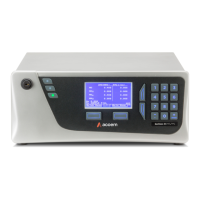1.5.4 NH
3
Scrubbers
NH
3
Scrubbers are placed in the measurement paths to remove any NH
3
before measurement of the
NO (or converted NO), as NH
3
may interfere with the reaction in the NO
2
to NO converter and
reaction cell.
The scrubber is filled with granular phosphoric acid which reacts with the ammonia to form
ammonium salts which are left behind in the scrubber as the other gases pass through unaffected.
The scrubber will eventually become blocked and less efficient through normal use and as it is a
consumable item will need replacing.
1.5.5 Delay Loop
In order to measure the NO and NO
X
sample at the same point in time in the reaction cell, a single
sample is split into two paths: NO and NO
X
. Each sample path is measured sequentially. The delay
loop is installed in the NO
X
path and along with the restriction of the NO to NO
2
converter is used to
extend the time the sample takes to reach the reaction cell. Tubing lengths in specific areas of the
instrument are critical and must not be changed. Changing these lengths will affect the timing of the
sample paths.
There is no delay loop for the N
X
channel, as the length of tubing to the external converter, combined
with further delays inside the HTO-1000N, make it impractical to sample the exact same gas sample.
1.5.6 Dryer
The dryer is constructed of Nafion tubing and is designed to remove water vapour from ambient air
that is then used by the ozone generator. The water is absorbed and moves through the walls of the
tubing, evaporating into the surrounding air. The remaining gas is unaffected. The flow control is
performed by utilising a critical orifice.
1.5.7 Ozone Generator
The ozone generator is a corona discharge ozone source driven by an ignition coil. Dry air is drawn
into the discharge tube via an orifice and ionised by a high voltage electrode. This yields O
3
from the
reaction 3O
2
→2O
3
. The ionisation takes place in the confines of a glass tube with the electrode
mounted on the outside. The amount of ozone generated is controlled by varying the energy to the
discharge tube. The ozone flow rate is 80 sccm with an ozone concentration of 6000-8000 ppm
(approximately).
1.5.8 NO
2
to NO Converter
The NO
2
to NO converter assembly has 4 major components.
NO
X
converter coil
N
X
converter coil
Ozone destroyer coil
Heated core with Thermocouple (~325°C)
The NO
X
and N
X
converter coils uses high temperature (~325°C) and a catalyst to convert any NO
2
in
the sample to NO. To obtain accurate and stable results, the converter must operate at above 96%
efficiency.

